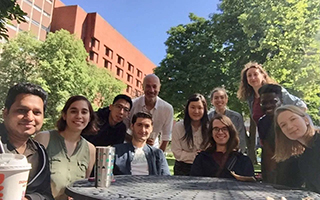April 19, 2022
Using computational approaches, Stefano Monti, Ph.D., aims to model environmental chemicals and predict their long-term effects on human health.

As a computational biologist, Stefano Monti, Ph.D., uses machine learning and bioinformatics to investigate the molecular drivers of disease – such as cancer and metabolic disorders – to understand how to prevent them.
His background in data science opened diverse career opportunities, but he ultimately found his passion in cancer research when he joined the Whitehead Institute’s Center for Genome Science. There, he explored the genetic mechanisms that lead to cancer to identify targets for improved therapies.
As he dove into cancer research, Monti recognized an imbalance in the resources and time invested in preventing disease compared to finding a cure.
“Finding a cure is an important pursuit and is also a major part of my research portfolio, but it is crucial that we pay more attention to the prevention aspect of cancer research,” Monti explained. “This is what inspired me to study chemicals that may increase the risk of developing cancer, called carcinogens. I believe prevention research can have enormous benefits for public health.”
Since 2012, Monti led the Bioinformatics and Molecular Modeling Core at the Boston University NIEHS Superfund Research Program (SRP) Center with prevention in mind.
Computational Models for Cancer Prevention
Monti and his team are developing computational models to predict long-term cancer risk from short-term chemical exposures.
Monti says he is proudest of his work related to the Carcinogenome Project, a screening process for predicting chemical carcinogenicity and genetic toxicity. By combining computational and experimental approaches, their approach can identify potential carcinogens quickly and accurately.
“Testing a chemical for its carcinogenicity potential is a costly and time-consuming process,” said Monti. “Our approach allows researchers to prioritize chemicals that will need to undergo more in-depth testing, such as in animals, to determine if they have the potential of causing cancer. This approach can ultimately save the researcher time and resources.”
The team makes their data, which for now includes gene expression profiles of liver and breast carcinogens and noncarcinogens, available to other researchers.
Linking Hazardous Substances to Metabolic Disorders
In collaboration with Jennifer Schlezinger, Ph.D., also of the Boston University SRP Center, Monti is using computational models to identify which chemicals may increase a person’s risk for metabolic disorders. Specifically, he is studying chemicals that disrupt the normal function of adipocytes – cells that store energy and regulate diverse processes, such as inflammation and glucose homeostasis.
There are two types of adipocytes, white and brown cells. White adipocytes store energy as fat and brown adipocytes disperse the stored energy as heat.
"Metabolic disorders occur when there is an imbalance between these two types of cells,” Monti explained. “Chemical exposures may throw off this balance, so we’re trying to identify which chemicals target these cells and how.”
For example, Monti and team observed that the chemicals tributyltin and triphenyl phosphate bind to a nuclear receptor that is essential in regulating how adipocytes differentiate and function.
The researchers have also developed several frameworks to classify and group together chemicals, such as to identify chemicals that target brown or white adipocytes and their downstream metabolic functions.
“Classification is the basis of most of our decisions, it allows us to organize our knowledge and understand the mechanisms that drive the similarities and differences between chemicals and how they affect cells,” said Monti. “Once we identify these mechanisms, we can study how to fix them.”

Improving Data Sharing
“One of the most challenging aspects of working with data is when it is not properly formatted, annotated, structured, and stored,” Monti shared. “One of our goals at the Boston University SRP Center is making sure that all data from all the different projects follow the FAIR principles – findable, accessible, interoperable, and reusable – so it can be shared and used to generate new findings.”
With the FAIR principles in mind, Monti and collaborators at the Oregon State University SRP Center launched a portal to facilitate chemical screening using data generated through their studies. This data is properly formatted and annotated, which will allow other scientists to reuse the data for their own research. Using supplementary funding from SRP, the team worked together to combine their data to better understand the mechanisms by which exposure to chemicals harm health.


